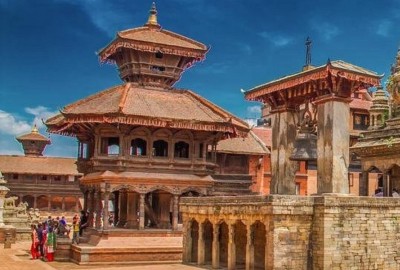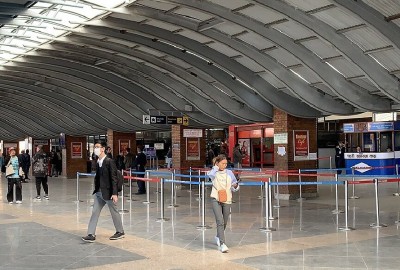Patan is one of the most lively cities in the kingdom of Nepal. It is also known as Lalitpur. Located 5 kilometers away from southeast Kathmandu, Lalitpur is one of the three major cities located inside the Kathmandu valley, besides Bhaktapur and Kathmandu. Its history dates back to as far as 2300 years ago. The people living here have a centuries-old living culture with a rich historical past, and a city that is flourishing with development. Lalitpur is the third-largest city of Nepal among fifty-eight municipalities.
Table of Contents
Plan your trip to Nepal
Customize your trip with help from a local travel specialist.
Since ancient times, Lalitpur has conserved its role in the geopolitical and economic arena of this country and safeguarded its unique place. Lalitpur was a sovereign city-state for many centuries. It was assimilated into the kingdom of Nepal in 1768 AD by King Prithivi Narayan Shah.
Lalitpur boasts about having the largest community of artisans, notably wood and metal workers, and is thus tremendously rich in arts and architecture. Moreover, the word Lalitpur translates to the city of fine arts. It has a large number of temples, chaityas, sacred buildings, monasteries, stupas, and shikhara. Lalitpur has produced a number of famous artists and craftsmen who have spread the legacy of the city and has made it renowned all over the world. The most famous craftsman being the legendary architect Arniko. UNESCO has also enlisted a great number of monuments in Patan Durbar Square as a World Heritage Site.
Patan is the oldest city in the Kathmandu valley according to tradition. The four main stupas with Ashok make it seem plausible but the claim has not been verified. But the fact could be true as Ashok had visited the birthplace of Buddha in Lumbini as well as having built stupas in widely separate places of India. The form of the mounds is also persistent with an early date of origin.
Lichhavi period and the inscriptions of Manadeva in the 5th century is where the history of Lalitpur begins. Referred in the inscriptions, the Managriha (House of Mana) may be pinpointed with the Mansiggal which was used by Malla kings later and is presumed to be what gave the name to the area adjoining the Durbar Square its name, Mangal Bazaar. Two other palaces mentioned in the inscription can not be identified. The name of one is Kailasakuti which seems to point to a monument with a high tower. It supports the hypothesis that peculiar Nepalese style timber structures were present in the early days.
Patan in the early days was known as Lalita Patana (the beautiful Patan) or Lalitpur and has been a principal town. From the inscriptions, its growth of religious institutions and ideas of antiquity can be gained. More than a dozen Shaivite and Buddhist Vaishnavite foundations have been listed by J.C. Regmi in Patan, in between the time period 467-783 A.D. and more have been listed in the time period 987-1475.
The oldest structure is hard to determine apart from the stupas. While the inscriptions of some pinpoint to the 14th century, the structures might have been reconstructed. The Malla period was a great period between the 16th-18th century when the now famous and most celebrated structures were erected and the older buildings holding religious values were refurbished or reconstructed.
Patan has perhaps remained a great center of Newari Buddhism because of Ashokans tradition and it is shown by the large number of Bahals and Buddhist arts and crafts. Lord Vishnu or Lord Shiva were followed by the Lichhavi rulers. While their symbolism on Buddhism is not clear, Patan held a special place for it. It is also not clear what the forms of the Vihars were in the early days and what relations they held with the Himalayan Buddhism or monastic communities of the early days. While the Sangha which gave rise to this form has departed, the plans of the old courtyard remain.
A combination of shrine and family residency is considered to be a modern Bahal and an organization of priests and laity who have descended from and retain an attachment to its ancestors are the modern Sangha. It is believed that the Kirat dynasty founded Lalitpur in the 3rd century B.C. and it was later expanded during the Lichchhavi period. During the medieval period, the Mallas further expanded it.
While there are many myths after Lalitpur's name, the one most people believe is of the God Rato Machhindranath. A team of three people representing three kingdoms of the valley brought the god here from Kamaru Kamakhya which is located in Assam, India. A farmer named Lalit carried the god to the valley all the way from Assam. The god was brought here to overcome the worst drought seen by the valley. People believed that God Rato Machhindranath housed powers that could make it rain. Hence, because of Lalit's effort, God was brought to the valley. Many people believe that the name of the city is kept Lalitpur in honor of Lalit while Pur means township in Nepal.
Places to Visit in Patan
Bhimsen Temple
Located at the end of Durbar Square, Bhimsen temple is dedicated to Bhimsen, one of the five Pandavas. Bhimsen is believed to have superhuman strength and is also the god of business and trade. Hence, the reason why the carvings on the temple depict him as a red muscleman who's crushing an elephant with a knee or lifting a horse. This temple has a unique rectangular plan and is three stories tall. While the temple was built ages ago, it was reconstructed in 1682 and has since been refurbished thrice- in 1935, 1967 and 2015 (after the earthquake).
Jagan Narayan Temple
Honoring the Hindu god of protection and maintenance, Lord Vishnu, this temple is one of the major temples in the region. Built-in the 17th century, this temple is imposing and tall. It is built in a pagoda-style with Sikhata construction; and to make it look like a mountain peak, rising towers are built through the temple. The style reflects the carvings from an older era and is heavily detailed and refined.
Hari Shanker Temple
Considered as an amalgamation of Lord Vishnu and Shiva, this temple is dedicated to a hybrid god. It is a three-story temple and manages to intrigue people with its roof struts and architecture. This temple was designed by King Yoganarendra Malla’s daughter in 1704/5 and is quite famous. The reconstruction of this temple is taking place as it was destroyed in the 2015 earthquake.
Patan Museum
While formerly this was the royal palace of the Malla kings, it now houses some of the finest assortments of art. Best known for its architecture as well as symbolism, this palace surrounds Keshav Narayan Chowk. The art is displayed in timber and brick rooms linked by narrow staircases.
Krishna Mandir Temple (Chayasim Deval)
Krishna Mandir is a well-known temple located in the middle of Patan Durbar Square. This temple is built in the Shikara style and one of the most noteworthy things of this temple is its second-floor pillar. Carvings from Mahabharata cover the first floor while the Ramayana story is told on the second floor. King Siddhinarasimh Malla believed he saw Radha and Krishna standing on the spot in which the temple is built. He constructed the temple in 1637 and it is three stories high and has twenty-one golden pinnacles. Shrines of Lord Krishna and Radha along with Rukmini are scattered in this temple and a floor is dedicated to Lord Shiva.
Golden Temple (Hiranya Varna Mahavihar)
This golden-colored temple has elaborate traditions and rituals for each ceremony. The elegance of Buddhist architecture and intricate carvings can be seen in this temple. Icons of goddess Arya Tara are scattered around the temple along with elephant structures and other artworks. Leather and shoes are prohibited inside the temple.
Temples of Machchhendra Nath and Min Nath
These temples show Vietnamese architecture from the past and are quite famous among tourists. People usually visit here to see the rich architecture of the temples. The artifacts inside the temple are locked in order to prevent theft. The temples are well preserved and looked after.








